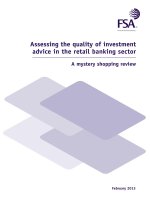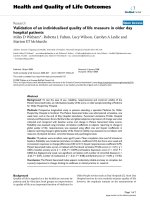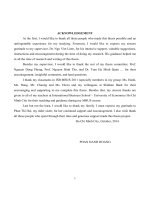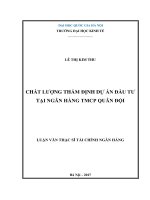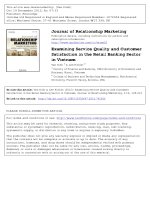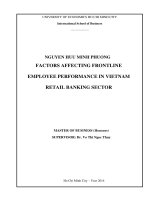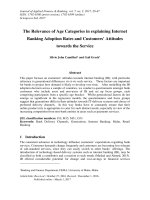Assessing the quality of investment advice in the retail banking sector docx
Bạn đang xem bản rút gọn của tài liệu. Xem và tải ngay bản đầy đủ của tài liệu tại đây (712.6 KB, 24 trang )
Assessing the quality of investment
advice in the retail banking sector
A mystery shopping review
February 2013
3
Assessing the quality of investment advice in the retail banking sector
Contents
Contents
Section One Summary 5
– Our review 5
– Our findings 5
– Our response 6
Section two Key causes of poor advice 7
– Poor risk profiling 7
– Failing to consider customers’ needs and circumstances 10
– Failing to consider the length of time customers want 11
to hold the investment
– Link to our work on inappropriate financial incentives, 12
sales targets and performance management
– Failing to give customers the correct information 13
– Inappropriate use of investment sales aids 15
– Weaknesses in firms’ controls 15
Section three Next steps 17
Annex 1 Examples of recent retail banking sector enforcement cases
Annex 2 Using mystery shopping
– Our approach
– Methodology
Assessing the quality of investment advice in the retail banking sector
Section 1 – Summary
5
1. Summary
Our review
The provision of investment advice to consumers is an important part of the financial services market
and one where consumers need to have trust and confidence in the industry. That is why we have
implemented the Retail Distribution Review (RDR), which came into force on 31 December 2012,
to ensure that consumers are treated fairly when they seek advice and advisers recommend the right
product for their needs.
1
We have undertaken a programme of work in this market
2
, including publishing guidance to help
firms improve the quality of their advice. This included a specific focus on how firms assess the level
of risk their customers are willing and able to take.
3
Following this work we recently undertook a mystery shopping review into whether firms in the retail
banking sector are giving their customers suitable investment advice. This paper discusses the results of
this review.
We decided to use mystery shopping to gather first-hand evidence of what someone looking for
investment advice from a bank or building society might experience. You can find more information
on mystery shopping and how we have used it in Annex 2.
Our findings
We assessed 231 mystery shops across six major firms in the retail banking sector,
focusing on the quality of advice given to customers looking to invest a lump sum.
The results show that while approximately three-quarters of customers received good
advice, we had concerns with the quality of advice in the other quarter.
In 11% of mystery shops we felt the advice was unsuitable for the customer and in a
further 15% the adviser did not gather enough information to make sure their advice
was suitable – so we could not tell if the customer received good or poor advice.
1 The RDR has changed our rules to address a number of long-standing issues in the market for retail investment products.
This includes amendments to how advisers are paid for advice, clearer descriptions of the service provided by firms, as well as
enhanced qualification levels and ethical and professional standards for advisers.
2 Annex 1 contains examples of recent enforcement cases on retail banking sector investment advice.
3 FG11/05: Assessing suitability: Establishing the risk a customer is willing and able to take and making a suitable investment
selection, (March 2011) – www.fsa.gov.uk/pubs/guidance/fg11_05.pdf.
“ while
approximately
three-quarters
of customers
received good
advice, we had
concerns with
the quality of
advice in the
other quarter.”
Assessing the quality of investment advice in the retail banking sector
Section 1 – Summary
6
The level of poor advice
4
varied significantly between the six firms. Although we found issues in all
of the firms we assessed, we were particularly concerned with the high level of poor advice we found
in some.
The main reasons for poor advice were that advisers’ recommendations were not suitable for
5
:
•
the level of risk customers were willing and able to take (15% of mystery shops);
•
customers’ financial circumstances and needs; for example, advisers failing to recommend the
repayment of unsecured debts, such as loans, where this would have been the right option for the
customer (13% of mystery shops); and
•
the length of time customers wanted to hold the investment (6% of mystery shops).
Although we are encouraged that the majority of firms have made changes to their advice processes
to try and deliver better outcomes for their customers, we are concerned that advisers in some firms
continue to make a number of basic financial planning errors.
Our response
Firms responded in a cooperative way to these findings and agreed to take immediate action in
response to our concerns. This includes retraining advisers, making substantial changes to advice
processes and controls for new business, and undertaking past business reviews to identify historic
poor advice and put this right for customers.
We required firms to employ an independent third party to either
carry out or oversee this work. We have also started an enforcement
investigation into one of the firms.
We encourage all firms to review the findings within this report, alongside
previous guidance in this area, and consider whether any of the issues we
have identified apply to their own businesses.
We will continue to supervise the investment advice sector intrusively to monitor how firms act in
response to the RDR and ensure they deliver good advice.
4 We use the term ‘poor advice’ to collectively describe the 11% of mystery shops where advice was ‘unsuitable’ and the 15%
of mystery shops where advisers ‘failed to ensure suitability’. Both of these ratings reflect a breach of our Conduct of Business
Rules (COBS) and the FSA’s Principles for Business. Advice was considered ‘poor’ as customers were at risk of suffering
detriment as a result of being recommended products that were not suitable for their needs and circumstances.
5 These categories are not mutually exclusive and a number of cases were rated ‘unsuitable’ and/or ‘failed to ensure suitability’ for
multiple reasons.
“Firms responded
in a cooperative
way and agreed
to take immediate
action in response
to our concerns”
7
Assessing the quality of investment advice in the retail banking sector
Section 2 – Key causes of poor advice
2. Key causes of poor advice
Poor risk profiling
In 15% of mystery shops we had concerns with the suitability of advisers’ recommendations for the
level of risk customers were willing and able to take. This resulted from flaws in how advisers assessed
risk with their customers.
Risk-profiling tools with complex and limited questions
Firms often use a risk-profiling tool to help assess their customers’ risk profile. These tools give this
process structure and help promote consistency between advisers. However, tools can have limitations
which produce flawed results in some circumstances.
6
Some of the questions in the risk-profiling tools we saw were not clearly worded, used phrases that
were open to interpretation or were too complex for some customers to answer. This risked customers
giving answers that resulted in their risk profile being assessed incorrectly.
7
Example of a customer misunderstanding a complex question
One firm’s risk-profiling tool contained a complex question that assumed customers had a particular level
of financial knowledge and mathematical ability. The question required customers to use percentages to
calculate potential investment losses based on different scenarios and then confirm the level of loss they
would be willing to accept.
In one mystery shop, the customer only realised the potential loss implied by their original answer
after the adviser explained it to him in more detail. However, advisers failed to check customers
understood the question in all mystery shops, even when they were clearly struggling to answer it.
This led to some customers’ risk profiles being assessed incorrectly and the adviser recommending an
unsuitable product.
6 FG11/05, p11.
7 FG11/05, pp12-13.
8
Assessing the quality of investment advice in the retail banking sector
Section 2 – Key causes of poor advice
Example of a customer struggling to engage with the risk-profiling process
One customer struggled to engage with a firm’s risk-profiling process as she found it difficult to
relate the questions to her own personal and financial circumstances.
The adviser asked the customer whether she wanted high investment returns even if this involved
risk. The customer replied ‘I don’t know, it depends on the risk. Probably in the middle [of the
potential options]. I suppose it would depend on how much risk there would be’. The adviser did not
provide the customer with any further explanation to help her answer the question and she settled
on the middle answer as a compromise. The adviser accepted this answer without comment.
The adviser then asked the customer whether she worried about financial matters more than her
friends. The customer replied ‘I hate questions like this. I don’t know what other people think…I
never speak to people about money. I don’t know if it would be more or less. Just put “in between”
as I haven’t got a clue’. As before, the adviser accepted the customer’s answer, even though it was
clear that her answer might not be accurate.
The adviser recommended a fund to match the risk profile suggested by the tool without checking
with the customer whether it was correct. We considered that this recommendation was unsuitable
as it exposed the customer to too much risk (which was clear from her wider circumstances and
other comments she made during the meetings with the adviser).
Unclear customer risk category descriptions
All six firms used risk category descriptions to summarise the results from their risk-profiling process
and check they had assessed customers’ risk profiles correctly. However, some of these descriptions
were unclear, as they used vague phrases that could be open to interpretation and failed to effectively
communicate the levels of risk involved.
8
Example of a poorly worded risk category description
In one firm, the ‘middle’ risk category highlighted the potential for the customer to lose money but did
not indicate the extent of the potential losses. A number of advisers also failed to give customers any
further information to help them understand the level of risk involved.
Because of this, we felt it would be difficult for customers to understand whether the risk category
accurately reflected the level of risk they were willing and able to take.
Failing to check the results from risk-profiling tools are correct
Where firms rely on risk-profiling tools they need to ensure they manage any limitations through
the suitability and ‘know your customer’ process.
9
However, some advisers were over-reliant on
the risk-profiling tools and failed to check whether customers’ risk profiles had been assessed
correctly.
10
Some advisers also failed to consider the customer’s ability to cope with any financial
losses on their investment (i.e. their ‘capacity for loss’).
11
8 FG11/05, pp15-18.
9 FG11/05, p4.
10 FG11/05, p15.
11 FG11/05, p3.
9
Assessing the quality of investment advice in the retail banking sector
Section 2 – Key causes of poor advice
Example of an adviser failing to confirm that a customer’s level of risk
was correct
One adviser assessed the customer’s attitude to risk by asking him to read through the firm’s risk
category descriptions and select the category he considered appropriate. The adviser accepted the
category selected by the customer without any further explanation or discussion and recommended
investment funds to match this risk profile.
We considered that the adviser had failed to take reasonable steps to ensure their recommendation was
suitable as:
• the risk category descriptions failed to effectively explain or illustrate the level of risk involved.
Given these limitations, we felt the customer was unable to make an informed decision on whether
thecategoryreectedhisriskprole;and
• theadviserfailedtocheckwhetherthecustomer’s‘self-selected’riskproleaccuratelyreectedthe
actual level of risk he was willing and able to take with his investment. This was particularly relevant
astheadviserhadidentiedthatthecustomerhadnopreviousinvestmentexperienceandlimited
nancialknowledge.
Some advisers failed to discuss and correct discrepancies between the results from risk-profiling tools
and other customer information. This was a particular concern where customers said things that
suggested a clear desire to take a different level of risk.
Example of an adviser failing to take account of wider customer information
One firm’s risk-profiling tool assessed a customer as ‘medium’ risk. However, this was inconsistent with
other statements she made to the adviser about the level of risk she wanted to take with her money.
While discussing her objectives, the customer stated her desire was for ‘safety’ and mentioned that she
did ‘not want to risk’ her money. However, the adviser failed to investigate or discuss the discrepancy
between these statements and the ‘medium’ risk category suggested by the firm’s risk-profiling tool. The
adviser also failed to discuss whether any loss of money would harm the customer’s standard of living.
We considered that the adviser’s recommendation for a medium risk investment portfolio that would
fluctuate in value on a daily basis and could result in potential losses was unsuitable for the risk the
customer was willing and able to take.
However, we also saw a number of good examples where advisers gathered enough wider information
to confirm the results from the risk-profiling tool were right for their customers.
10
Assessing the quality of investment advice in the retail banking sector
Section 2 – Key causes of poor advice
Example of an adviser checking the risk the customer was willing and able
to take
One adviser talked through the suggested result from the firm’s risk profiling tool with the customer to
confirm it was correct. This included:
• clearlydescribingpotentialriskcategoriesforthecustomer;
• using example scenarios – based on the amount of money the customer wanted to invest – to help
establishthelevelofriskhewaswillingtotake;and
• highlightingthedifferencebetweentheriskproleofthecustomer’sexistingassetsandtheassets
within the recommended product.
The adviser also asked specific questions about the customer’s capacity for loss.
Failing to consider customers’ needs and circumstances
In 13% of mystery shops we had concerns with the suitability of recommendations for customers’
financial circumstances and needs.
12
The main problems we found were:
• advisers failed to gather enough information about customers’ income, assets and financial
commitments to ensure the recommendation was suitable for their financial circumstances; and
• advisers failed to recommend that customers repay existing unsecured debts, such as credit cards
and loans, where this would have been in the customers’ best interests.
13
Example of an adviser failing to gather necessary information
One adviser failed to gather enough information on the customer’s income, current and future tax
status, existing assets and regular financial commitments.
Because of this, it was not possible to assess whether the recommended product was suitable for
the customer’s financial circumstances and needs. We considered that the adviser had failed to take
reasonable steps to ensure the recommendation was suitable for the customer.
12 As required by COBS 9.2.2R. In addition, COBS 9.2.6R sets out that a firm must not make a personal recommendation where
they do not obtain the necessary information to assess suitability.
13 COBS 2.1.1R.
11
Assessing the quality of investment advice in the retail banking sector
Section 2 – Key causes of poor advice
Example of an adviser failing to recommend repaying unsecured debts
One adviser identified that the customer had around £9,000 of credit card debt. The customer was
only making the minimum repayment amount each month and the outstanding balance was accruing a
significant level of interest.
The adviser failed to recommend that the customer repay this credit card debt and instead
recommended an investment within a collective investment scheme. The customer was likely to be
worse off, as the interest on the credit card debt was likely to be higher than the investment returns
(and paying off the credit card would not have involved any investment risk).
We considered that the adviser’s recommendation was not in the customer’s best interests and was
unsuitable for his financial circumstances and needs.
Most firms had a structured approach to fact-finding that made sure advisers gathered the information
necessary for advising on a lump sum investment. The firms that did this well consistently used
systems that prompted advisers to ask relevant questions on each customer’s investment objectives,
financial situation and knowledge and experience.
Some firms also used a set of common advice principles to try and minimise the risk of poor advice by
guiding how advisers structured their investment recommendations. For example, one firm restricted
the amount of money that customers with no investment experience were allowed to initially invest.
In the mystery shops with issues, we found that advisers:
•
carried out their fact-finding in a rushed or unstructured way and failed to
gather relevant information;
•
did not ask appropriate follow-up questions on certain areas; for example,
some advisers identified that customers had unsecured debts but failed
to find out the amount of debt, the level of interest being paid, the term
outstanding or whether any repayment penalties applied; and
•
collected the necessary information, but did not take it into account
when making their recommendations.
Failing to consider the length of time customers want to hold
the investment
In the majority of mystery shops, advisers gathered enough information to ensure the term of the
product they recommended was suitable for each customer’s objectives. For example, advisers made
sure that products with restrictions on when customers could access their money were suitable and
explained the nature of any restrictions clearly.
However, in 6% of mystery shops we had concerns with the suitability of the recommended product
for the length of time the customer wanted to hold the investment.
We found that some advisers recommended medium to long-term investments even though customers
made it clear they would need their money after three to four years. We are particularly concerned
“some advisers
recommended
medium to long-
term investments
even though
customers would
need their money
after three to
four years”
12
Assessing the quality of investment advice in the retail banking sector
Section 2 – Key causes of poor advice
about these failings as the majority of the mystery shops based upon the short, three to four year
advice scenario resulted in unsuitable advice (see Annex 2 for details of our methodology).
Example of an adviser recommending a product that was unsuitable for the
customer’s investment term
One customer wanted to invest for three years so she could help buy a house for her son.
The customer confirmed that this term was to coincide with her son returning to the UK from a fixed-
term employment contract abroad. However, the adviser attempted to influence her to extend the term.
After some discussion the customer said that a term of between three to four years was possible and
the adviser recommended a collective investment scheme.
The adviser stated that as the product was a medium-term investment they would ‘have to technically
recommend that [the product remain invested] for five years’. However, when the customer made it clear
that her three to four-year term was not negotiable the adviser contradicted their earlier statement and said
that medium term meant ‘three to five years’. The adviser then stated the firm had ‘to recommend three to
five years to be on the safe side’. These statements contradicted the product’s key features document.
We considered that the recommended medium to long-term product was unsuitable for the customer’s
short, three to four year investment term. If the investment had been made, the customer had an
increased risk of getting back less than she had originally invested due to the short term and the impact
of the initial charges.
Link to our work on inappropriate financial incentives, sales targets
and performance management
Our review clearly showed some advisers recommending investment products over non-investment
products, even when they were not suitable for customers. For example, we found some advisers
recommending investments when they should have advised the customer to place their money in a
deposit product.
In some of the mystery shops, advisers gathered the information necessary to
be able to determine what would have been suitable for the customer but still
recommended an unsuitable product. Some advisers’ recommendations also
appeared to be at odds with their firms’ advice guidelines. So we think there may
be other factors causing poor advice.
We published guidance on the risks to customers from financial incentives in January 2013.
14
This
followed thematic work which found that a number of firms had incentive schemes that could
encourage mis-selling unless adequate controls were in place. The report also highlighted the need for
firms to manage the risks from sales targets and performance management.
We expect all firms to consider whether their incentive schemes increase the risk of mis-selling and to
put in place adequate governance and controls to prevent this.
We will carry out a review later in 2013 to see whether firms have acted on our guidance.
14 FG13/01: Risks to customers from financial incentives, (January 2013) www.fsa.gov.uk/static/pubs/guidance/fg13-01.pdf
“we think there
may be other
factors causing
poor advice”
13
Assessing the quality of investment advice in the retail banking sector
Section 2 – Key causes of poor advice
Failing to give customers the correct information
We assessed that advice disclosure was unacceptable in 42% of mystery shops as advisers failed to give
customers the correct information.
15
The main problems we found were
16
:
•
advisers failed to give customers the required initial disclosure on the firm, its services
and remuneration (13% of mystery shops);
•
advisers made statements to customers that were unclear, unfair and/or misleading (15% of
mystery shops); and
•
advisers gave customers suitability reports that contained inaccurate information and/or failed to
explain the disadvantages of the recommendation (17% of mystery shops).
Initial disclosure on the firm, its services and remuneration
Most advisers gave customers the required information on the firm, its services and remuneration.
17
Advisers provided customers with the ‘Keyfacts about our services and costs’ document at the start of
the meeting and often discussed the document’s contents with customers. This allowed the adviser to
answer any questions and ensured customers understood the basis on which they were being advised.
Example of an adviser discussing the initial disclosure on the firm, its services
and remuneration with the customer
The adviser went through the contents of the firm’s ‘Keyfacts about our services and costs’ document
with the customer at the beginning of their first meeting.
The adviser took time to explain key information and check the customer understood it. This included
the adviser making it clear that the customer would pay for their services through commission and
using an example to show how the amount of commission would vary depending upon the investment
amount and the product recommended. The adviser also explained the extent of the customer’s
entitlement to compensation under the Financial Services Compensation Scheme (‘FSCS’) for different
types of product.
During this process, the adviser was able to answer the customer’s immediate questions and also gather
some information on the customer’s needs and objectives.
In 13% of mystery shops advisers failed to give customers the required information or described it in a
misleading way.
15 We judged disclosure as ‘unacceptable’ in cases where we had evidence of a breach of the disclosure rules within COBS or
Principle 7.
16 These categories are not mutually exclusive and a number of cases were rated ‘unacceptable’ for multiple reasons.
17 COBS Chapter 6.
14
Assessing the quality of investment advice in the retail banking sector
Section 2 – Key causes of poor advice
Example of an adviser making a misleading statement on how the customer
would pay for advice
The adviser told the customer ‘you don’t pay me a penny [and] you don’t pay the bank a penny for this
advice’. We considered this misleading as the firm’s ‘Keyfacts about our services and costs’ document
made it clear that although the customer might not have to pay anything upfront, the firm’s service
was not free and the customer would pay by commission indirectly through product charges.
Advisers making statements that were unclear, unfair or misleading
In 15% of mystery shops advisers made misleading statements to the customer.
18
These were most
commonly on the risks and performance of potential products.
Example of an adviser making a misleading statement
One adviser made a number of misleading statements about the features and potential investment
returns of the product they were recommending.
The adviser incorrectly stated that the customer would ‘always get a return’ and told him that the
potential return from the product was three and a half times more than the maximum return that was
actually achievable. The adviser reinforced this misleading statement by writing down the amount the
customer ‘could’ get back based on his initial investment.
The adviser also made misleading statements about how the product was managed and gave no
risk warnings. The adviser appeared to rely on the customer’s lack of experience to not question or
challenge the product information.
This misleading disclosure meant the customer was not able to judge whether the product was suitable
for his needs and circumstances.
Issues with suitability reports
In 17% of mystery shops advisers gave customers suitability reports that were either misleading or failed
to explain the possible disadvantages of the advice to the customer.
19
The majority of these misleading
statements related to suitability reports that did not reflect what was discussed during meetings.
Example of an adviser issuing a misleading suitability report
One customer made it clear to the adviser that she wanted to invest her money for three years and
then use the money to go on an exotic holiday. The adviser recommended a medium to long-term
investment product.
The suitability report setting out the recommendation was misleading as it stated that the customer wanted
to invest for ‘at least five years’ and was keen to follow a ‘medium to long-term investment strategy’.
18 COBS 4.2 and Principle 7.
19 COBS 9.4.7R.
15
Assessing the quality of investment advice in the retail banking sector
Section 2 – Key causes of poor advice
As suitability reports did not accurately reflect discussions between customers and advisers, we were
concerned that firms’ business monitoring teams might not be able to identify poor advice when they
carried out their file reviews. We were also concerned that firms’ complaint handling teams might
make the wrong decisions about customer complaints if they relied on these inaccurate records during
their investigations.
Inappropriate use of investment sales aids
Some firms used ‘investment sales aids’ to compare the potential returns
customers could get from investment products with cash deposits.
We were concerned that:
•
the interest rates some sales aids used to show the returns from cash
deposits did not always reflect the actual returns available from the
firm’s deposit products, so they undervalued cash deposits and made
investments appear more attractive; and
•
advisers’ descriptions of the results from the sales aids were often unbalanced and potentially
misleading; for example, we saw a number of cases where advisers emphasised the potential
returns from the investment product without mentioning the potential for losses.
20
Example of an adviser using a sales aid in a misleading way
The adviser used an investment sales aid as part of the risk-profiling process to show the customer the
potential returns from a ‘medium risk’ investment portfolio linked to his ‘medium’ risk profile.
The investment sales aid suggested the customer would receive a positive return on his investment at
the end of the term. The adviser reinforced this by telling the customer this positive return was the
‘lowest potential return’ he could get back and represented the ‘worst case scenario’. We considered this
misleading as the firm’s medium risk portfolio did not guarantee a positive return. The portfolio was
invested in assets that would fluctuate in value on a daily basis and expose the customer to the risk of
potential losses.
Weaknesses in firms’ controls
Some firms had very structured advice processes that directed how advisers assessed the suitability of
products for customers. For example, by placing upper limits on the amount of customer assets that
advisers were allowed to invest or restricting the level of risk certain types of customer were allowed
to take.
In some mystery shops, advisers appeared unable to override the constraints of their advice processes,
even when it would have been suitable for customers. Instead, advisers deliberately used inaccurate
customer information – by increasing the customer’s investment term or income level – to get round
the firm’s controls and allow them to amend the suggested recommendation.
20 COBS 4.5.6R.
“ advisers emphasised
the potential returns
from the investment
product without
mentioning the
potential for losses ”
16
Assessing the quality of investment advice in the retail banking sector
Section 2 – Key causes of poor advice
Although this did not result in poor outcomes in the mystery shops we
assessed, we were concerned that:
•
the suitability reports these advisers produced contained inaccurate
and potentially misleading statements on customers’ needs and
financial situations that could result in harm if customers ever needed
to complain;
21
and
•
this form of system manipulation might not be identified by firms’ controls.
Example of an adviser manipulating the firm’s advice processes
The adviser told the customer ‘If I only put a five year timescale in, because you have no experience in
the stock market, [the system] will probably drop you to cautious [risk]. If you want the better growth
potential of a balanced [investment] we may need to put in a longer investment term, but after three
years you can get it out’. The adviser then put a 20 year term into the firm’s systems and continued
with the advice.
The suitability report given to the customer was inaccurate and misleading as it reflected the incorrect
20 year term rather than the customer’s actual objective.
21 We were also concerned that this may have also resulted in firms’ systems recording inaccurate and potentially misleading
information about customers.
“the suitability reports
these advisers produced
contained inaccurate
and potentially
misleading statements”
17
Assessing the quality of investment advice in the retail banking sector
Section 3 – Next steps
3. Next steps
Firms responded in a cooperative way to these findings and agreed to take immediate action in
response to our concerns. This includes:
•
retraining their advisers;
•
making substantial changes to their advice processes for new customers;
•
putting stronger controls in place to monitor the quality of advice; and
•
undertaking past business reviews to identify historic poor advice and put this right for customers.
We required firms to employ an independent third party to either carry out or oversee this work.
We have also started an enforcement investigation into one of the firms.
We encourage all firms to review the findings within this report, alongside previous guidance in this
area, and consider whether any of the issues we have identified apply to their own businesses.
We will continue to supervise the investment advice sector intrusively to monitor how firms act in
response to the RDR and ensure they deliver good advice.
19
Assessing the quality of investment advice in the retail banking sector
Annex 1
Annex 1: Examples of
recent retail banking sector
enforcement cases
Santander fined £1.5 million for failing to clarify FSCS cover on structured products
(February 2012)
‘Santander did not provide investors with sufficiently clear information about the scope of FSCS cover
for its structured products.’
‘…it failed to take adequate, timely steps to clarify the issue and to ensure its advisers and/or investors
were properly informed about these limitations.’
www.fsa.gov.uk/static/pubs/final/santander.pdf
HSBC fined £10.5 million for failings relating to investment advice and sales of investment
products provided by NHFA Limited (NHFA) (December 2011)
‘…no consistent approach to assessing customers’ attitude to risk or use of a suitable risk profiling
questionnaire.’
‘There was inadequate diversification of investments and savings plans…with little or no consideration
given to the use of other suitable forms of investment.’
‘…out of the 22 customer files reviewed by the third party, only two were deemed to contain wholly
suitable recommendations.’
www.fsa.gov.uk/static/pubs/final/hsbc_2dec11.pdf
Coutts & Company fined £6.3 million for failing to take reasonable care to ensure the
suitability of its advice and discretionary decisions (November 2011)
‘Coutts’ sales documentation did not accurately or adequately describe the fund and its risks.’
‘Coutts failed to have an adequate sales process in place for the fund…advisers were not provided with
adequate training on the fund and its features and risks were not sufficiently explained to them.’
‘…recommended the fund to some customers even though it may not have provided them with the
level of capital security they appear to have required.’
www.fsa.gov.uk/pubs/final/coutts.pdf
20
Assessing the quality of investment advice in the retail banking sector
Annex 1
Norwich and Peterborough Building Society (N&P) fined £1.4 million for failings relating to its
sales of structured investment products provided by Keydata Investment Services Limited
(April 2011)
‘N&P did not take reasonable care to ensure the suitability of its advice for all customers entitled to
rely upon its judgement.’
‘In a significant number of cases, N&P failed correctly to assess the risk that a customer was willing
and able to take.’
‘N&P’s advisers failed to assess properly the personal circumstances and needs of many of the
customers to whom they sold Keydata products, assessing them as having a higher tolerance of risk
than was appropriate.’
‘Certain customers were advised to move out of lower risk products (such as deposit accounts) into
Keydata products, although they had not indicated a willingness to expose themselves to the risk of
potentially losing all their capital.’
www.fsa.gov.uk/pubs/final/norwich_peterborough_building_society.pdf
Barclays fined £7.7 million for failing to take reasonable care to ensure the suitability of its
advice regarding the Funds (January 2011)
‘Barclays failed to take reasonable care to ensure the suitability of its advice.’
‘The Balanced Fund was risk-rated ‘balanced’ when under Barclays new approach it should have been
‘adventurous’…complaints indicated that customers were unaware of the risks associated with the funds.’
‘Sales files failed to evidence the suitability of products recommended to customers, including because
insufficient details of customers’ circumstances were recorded on the files.’
‘…training material did not specify who, in view of inherent risks, the Funds should be sold to.’
‘The Funds were incorrectly promoted in product literature as appropriate for customers wishing to
invest for capital growth.’
‘Product brochures and other documentation given to customers by Barclays contained inadequate
information and statements which could have misled customers about the nature and levels of
risk involved.’
www.fsa.gov.uk/pubs/final/barclays_jan11.pdf
21
Assessing the quality of investment advice in the retail banking sector
Annex 2
Annex 2: Using
mystery shopping
Our approach
We want to use mystery shopping as part of our supervisory approach. Where we identify potential
risks to consumers, we will consider whether mystery shopping could provide the evidence needed to
intervene earlier and tackle the underlying issues driving poor outcomes for consumers.
What is mystery shopping?
Mystery shopping involves the use of individuals trained to experience and measure any customer
service process, by acting as potential customers and reporting back on their experiences in a detailed
and objective way.
Mystery shopping is a long-established research technique and is used extensively in many industry
sectors to measure the quality of service provided.
Why do we use mystery shopping?
Mystery shopping gives us a detailed insight into the way firms sell financial products to their customers.
The evidence from mystery shopping lets us know what advisers actually say to customers in ‘real sales’
situations. It also allows us to compare what advisers tell customers during the advice process with their
formal records of the sale.
Methodology
How we gathered our evidence
This review assessed the quality of lump-sum investment advice for six firms within the retail banking
sector. We employed a specialist mystery shopping market research firm (GfK Mystery Shopping) to
conduct the mystery shops on our behalf. Mystery shops took place between March and September 2012.
The market research firm selected mystery shoppers from the panel who volunteered for the project.
Mystery shoppers were not aware the FSA commissioned the project.
The market research firm pre-screened mystery shoppers to remove two sub-groups of customers:
•
customers with assets over £150,000 were excluded to avoid potential referrals to any firm’s advice
services for wealthier customers (as the project focused on ‘high-street’ advice); and
22
Assessing the quality of investment advice in the retail banking sector
Annex 2
•
customers with unsecured debt in excess of £15,000 were excluded to avoid outcomes where
shoppers might only be advised to pay-down existing debts and so not receive any investment advice.
The market research firm filtered mystery shoppers to ensure that not all of the shoppers were totally
unwilling to take investment risk. This was to avoid too many mystery shoppers being directed to staff
who could only discuss savings products. The market research firm did not share the results of this
filtering exercise with the FSA and so it did not form part of the FSA’s suitability assessment.
Mystery shoppers were instructed to approach each firm for advice based on one of the
following scenarios:
•
investing a lump sum of £30,000 to £40,000 for growth for a term of at least five years (90% of
mystery shops); or
•
investing a lump sum of £30,000 to £40,000 for growth for a term of three to four years (10% of
mystery shops).
22
Mystery shoppers did not follow a prepared script. Other than the advice scenario, they were
asked to behave naturally and answer any questions they were asked based on their own personal
circumstances and financial situation. Mystery shoppers were instructed to proceed as far as they
could within the sales process for the relevant product but not actually complete the transaction.
The mystery shoppers recorded all of their meetings, so everything the adviser told the customer was
captured. Copies of these audio recordings, along with any documents advisers provided the mystery
shoppers, were given to us to assess.
Mystery shoppers were only allowed to complete one shop per firm and two shops across the entire
exercise. This prevented any bias arising from individual shoppers within the sample. Mystery shops
were spread across a geographically diverse population of branches and advisers. The sampling
approach provides us with confidence that our results are representative of each firm’s wider sales.
How we assessed the mystery shops
We assessed the mystery shops based on the evidence in the audio recordings of the meetings
between mystery shoppers and advisers, as well as the documents given to mystery shoppers during
the advice process.
Case assessments focused on:
•
Suitability: Were advisers’ personal recommendations suitable for customers? For example, was the
recommendation suitable for the length of time customers wished to hold the investment and the
level of risk customers were willing and able to take.
23
•
Disclosure: Did advisers give customers the documents required under COBS (for example, pre-sale
disclosure about the firm, its services and remuneration and product disclosure)? We also assessed
whether the contents of advisers’ conversations with mystery shoppers were clear,
fair and not misleading.
24
22 We only used the short, three to four year investment term scenario in 10% of shops as good advice was unlikely to result in a
recommendation for an investment product that we could assess.
23 As required by COBS 9.2 and under FSA Principle for Business 9.
24 As required by COBS Chapters 4, 6, 9 and 14 and FSA Principle for Business 7.
The Financial Services Authority
25 The North Colonnade Canary Wharf London E14 5HS
Telephone: +44 (0)20 7066 1000
Website:
www.fsa.gov.uk
Registered as a Limited Company in England and Wales No. 1920623. Registered Office as above.


